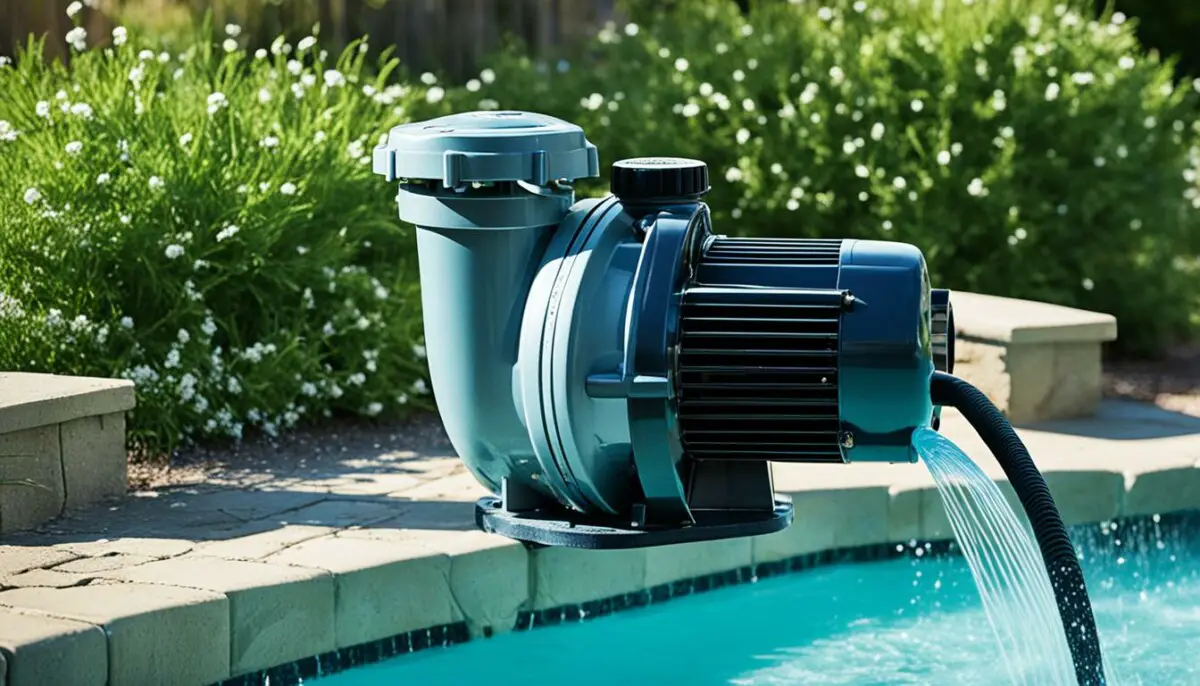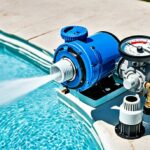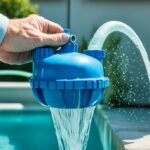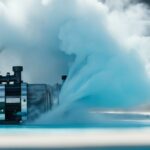Last Updated on 3 months by Francis
Is your pool pump experiencing low pressure and not working properly? This common issue can lead to reduced water flow, inefficient pool cleaners, and poor filtration. Don’t worry, there are quick fixes to solve low pressure problems in your pool pump and restore its optimal performance.
When it comes to low pressure in a pool pump, the most common cause is a blockage or restriction on the suction side of the pump. This can be caused by clogged skimmer and strainer baskets, a clogged pump impeller, or a suction leak in the system.
To address the low pressure issue, start by checking and cleaning the skimmer and strainer baskets. Remove any debris that may be causing a blockage. Next, inspect the pump impeller for clogs or damage. Clean or replace it if necessary. Finally, check for any leaks in the suction side of the system and repair them if found.
By following these quick fixes, you can restore your pool pump’s optimal performance and ensure clean and safe swimming conditions for you and your family.
Contents
Key Takeaways:
- Low pressure in a pool pump can lead to reduced water flow, inefficient pool cleaners, and poor filtration.
- The most common cause of low pressure is a blockage or restriction on the suction side of the pump.
- Clogged skimmer and strainer baskets, a clogged pump impeller, or suction leaks can cause low pressure.
- Check and clean the skimmer and strainer baskets, inspect the pump impeller, and repair any leaks to fix low pressure issues.
- Restoring the proper functioning of your pool pump ensures clean and safe swimming conditions.
Causes of Low Pressure in Pool Pump
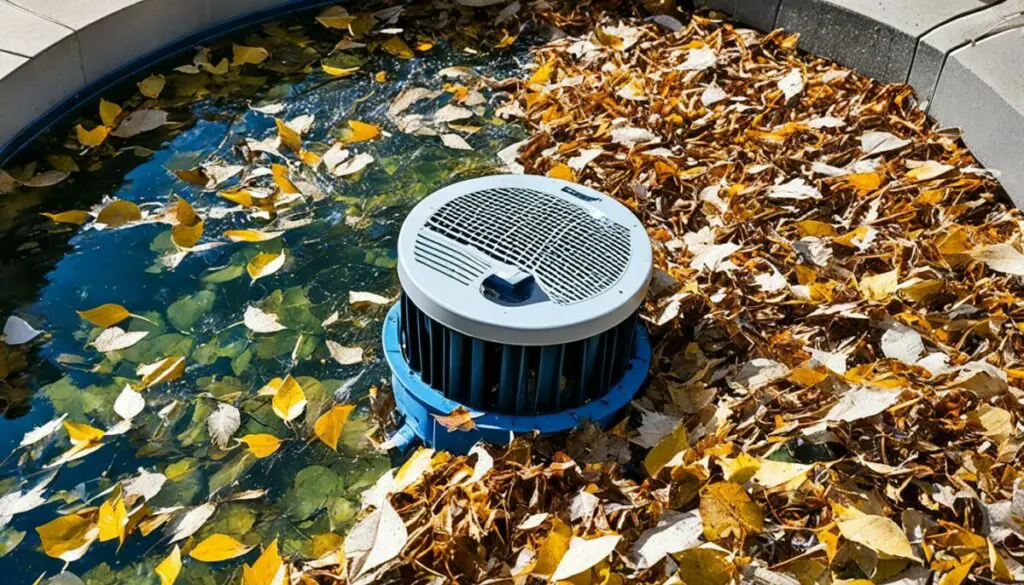
Understanding the causes of low pressure in your pool pump is essential for troubleshooting and resolving the issue. Several factors can contribute to low water pressure, preventing your pool pump from effectively circulating water. By addressing these causes, you can restore optimal performance to your pool pump.
Blockage or Restriction in the Suction Side
One of the most common causes of low pressure is a blockage or restriction in the suction side of the pump. This occurs when debris accumulates in the skimmer and strainer baskets, hindering water flow. Additionally, a clogged or damaged impeller can also impede the suction process, resulting in reduced pressure. Lastly, a suction leak in the system can allow air to enter and disrupt the pump’s performance.
It is crucial to properly maintain and clean the skimmer and strainer baskets to prevent blockages. Regularly check for debris and remove any buildup to ensure optimal water flow. If the pump impeller is clogged or damaged, it may need cleaning or replacement. Addressing any suction leaks in the system, such as loose fittings or damaged pipes, is also essential to restore water circulation and increase pressure.
List of Causes:
- Clogged skimmer and strainer baskets
- Clogged or damaged pump impeller
- Suction leaks in the system
To further illustrate the causes of low pressure in a pool pump, refer to the table below:
| Cause | Description |
|---|---|
| Blockage in skimmer and strainer baskets | Accumulated debris restricts water flow into the pump. |
| Clogged or damaged impeller | Impeller blockage or damage reduces the pump’s suction power. |
| Suction leaks | Leaking fittings or damaged pipes allow air to enter the system, disrupting water circulation. |
By addressing these causes and taking appropriate measures, you can resolve low pressure issues in your pool pump. Maintain regular maintenance and check for any blockages, clogs, or leaks to ensure your pool pump operates at optimal performance.
Troubleshooting Low Pressure in Pool Pump

When your pool pump is experiencing low pressure, it can disrupt the overall performance of your pool system. Reduced water flow, inefficient pool cleaners, and inadequate filtration are common issues associated with low pressure. The good news is that troubleshooting and fixing low pressure in your pool pump is possible. By following a few simple steps, you can identify and address the underlying issues causing the problem.
Step 1: Check the Skimmer and Strainer Baskets
One of the main culprits behind low pressure in a pool pump is a blockage or restriction on the suction side. Begin by examining the skimmer and strainer baskets. Remove any debris or obstructions that may be hindering proper water flow. Clean the baskets thoroughly, ensuring they are free from leaves, dirt, and other debris that might accumulate over time.
Step 2: Inspect the Pump Impeller
The pump impeller plays a crucial role in pulling water into the pump and generating pressure. Inspect the impeller for any clogs or damage that could impede its function. If you notice any blockages, carefully remove them using a soft brush or a small stick. In some cases, you may need to clean or replace the impeller to restore optimal performance.
Step 3: Check for Suction Leaks
A suction leak in the pool system can cause low pressure in the pump. Inspect the suction lines, valves, and fittings for any signs of leakage. Common areas where leaks occur include the pump lid, valves, and unions. If you find any leaks, tighten or replace the affected components as necessary to address the issue.
Step 4: Verify the Pool Water Level
Ensure that the pool water level is at the proper height for optimal suction. If the water level is too low, it can lead to decreased pressure in the pump. Add water to your pool until it reaches the recommended height, usually halfway up the skimmer opening. This will help maintain adequate water flow and prevent low pressure issues.
By following these troubleshooting steps, you can effectively address and resolve low pressure in your pool pump. Keep in mind that if the problem persists or you’re unsure about performing any maintenance tasks, it’s always best to consult a pool care professional for assistance. Maintaining the proper functioning of your pool pump not only improves water circulation but also ensures a clean and enjoyable swimming experience.
| Step | Troubleshooting Action |
|---|---|
| 1 | Check the Skimmer and Strainer Baskets for debris and clean if necessary |
| 2 | Inspect the Pump Impeller for clogs or damage and clean or replace if needed |
| 3 | Check for Suction Leaks in the pool system and repair if found |
| 4 | Verify the Pool Water Level and add water as needed |
What Should My Pool Pump Pressure Be?
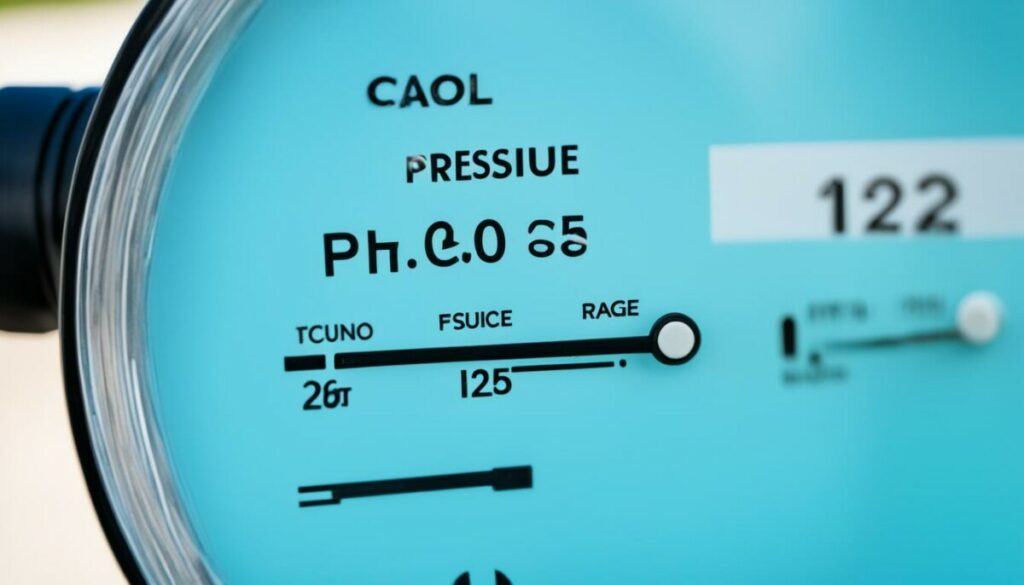
When it comes to your pool pump, maintaining the correct pressure is essential for optimal performance and functionality. The ideal pool pump pressure can vary depending on factors such as the specific pump model and your pool setup. However, a normal reading typically falls around 10 PSI (pound-force per square inch).
To determine the normal pressure range for your pool, it’s best to reference your pump’s owner’s manual or consult a pool care professional. They can provide specific guidelines based on your equipment. It’s important to monitor the pressure gauge regularly to ensure that it stays within the normal range.
If you find that the pressure is consistently too low or too high, it may indicate an issue with the filtration system or pump operation. A low pressure reading could suggest a blockage or restriction in the suction side of the pump, preventing it from effectively pulling in water. On the other hand, a high pressure reading might signal a clogged pool filter or a leak in the system.
Maintaining the correct pool pump pressure is crucial for ensuring efficient water circulation, proper filtration, and a clean swimming environment. It’s always a good idea to address any pressure issues promptly to prevent further damage and maintain the longevity of your pool equipment.
Image:
Pool Pump Pressure Guidelines
| Type of Pressure | Pressure Range (PSI) | Possible Issues |
|---|---|---|
| Normal Pressure | Around 10 | No major issues, optimal pump performance |
| Low Pressure | Below 10 | Possible blockage or restriction on the suction side, clogged impeller, or suction leak |
| High Pressure | Above 20 | Possible clogged pool filter or leak in the system |
Regularly monitoring and maintaining the pressure in your pool pump is an important part of pool maintenance. If you notice consistently low or high pressure readings, it’s recommended to troubleshoot the issue or seek assistance from a pool care specialist. By ensuring the proper pool pump pressure, you can enjoy a smoothly running pool and a refreshing swimming experience.
How Do I Know When My Pool Pump’s Pressure is Too High?
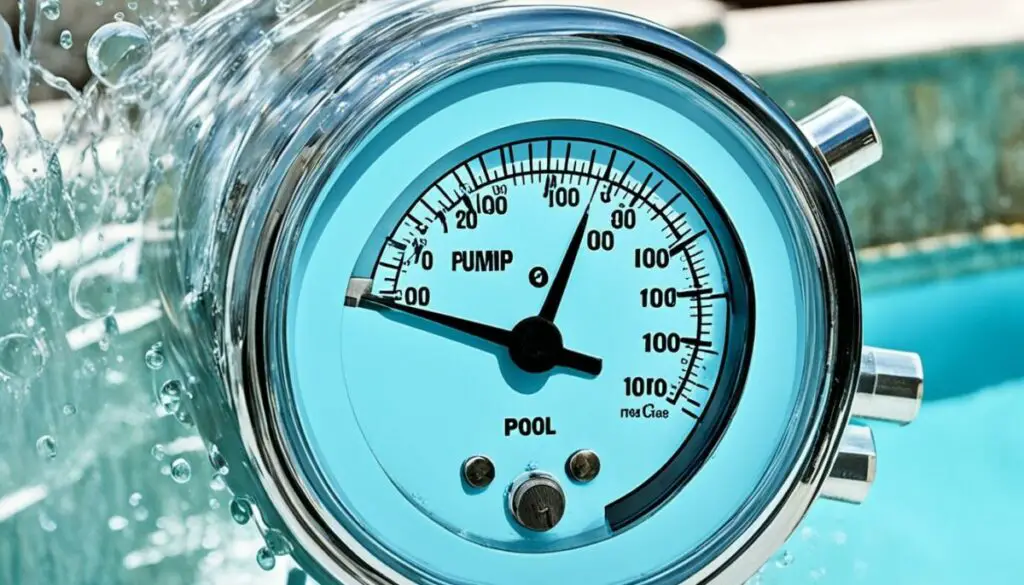
If you notice that your pool pump’s pressure gauge is reading more than 10 PSI higher than the normal reading, it is a clear indication that the pressure is too high. High pressure in a pool pump can lead to various issues and impact its performance. To resolve the problem and prevent further damage, it is essential to identify and address the causes of increased pressure.
The main culprits of high pressure in a pool pump are typically a clogged pool filter or a leak in the filter system. When the filter is clogged, water flow is restricted, causing the pump to work harder and generate higher pressure. On the other hand, a leak in the filter system can disrupt the proper functioning of the pump, leading to increased pressure.
Addressing High Pressure in Your Pool Pump
If you suspect that your pool pump’s pressure is too high, there are several steps you can take to alleviate the issue:
- Clean the Pool Filter: Start by cleaning the pool filter to remove any debris or contaminants that may be causing the blockage. This can help restore proper water flow and reduce the pressure on the pump.
- Backwash the Sand Filter: If you have a sand filter, backwashing it can help remove trapped debris and alleviate pressure build-up. Consult your pool equipment’s manual for detailed instructions on how to backwash the sand filter properly.
- Repair Filter System Leaks: If the pressure remains high after cleaning the filter, there may be a leak in the filter system that needs to be addressed. Inspect the system for any visible leaks and contact a pool professional for repairs if necessary.
Regular maintenance and monitoring of your pool pump’s pressure gauge are crucial to prevent and address high pressure issues. By taking these proactive steps, you can ensure optimal pool pump performance and maintain a clean and safe swimming environment.
How Often to Run a Pool Pump and For How Long
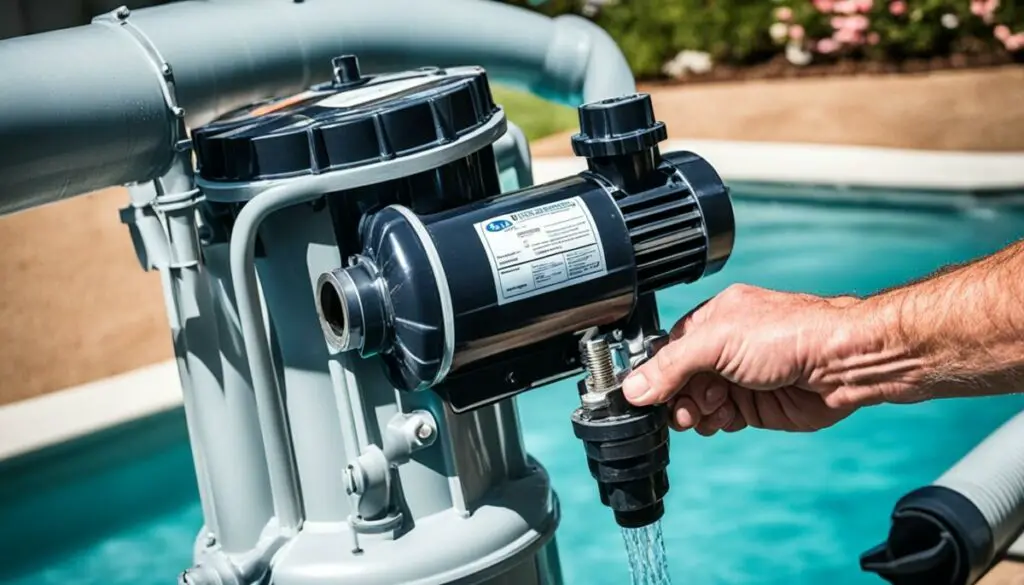
The frequency and duration of running your pool pump depend on various factors, including the pump type, pool size, and maintenance needs. To ensure optimal pool pump performance and maintain clean and safe swimming conditions, it is important to establish a proper running schedule.
As a general guideline, it is recommended to run a pool pump for at least four to eight hours per day. However, specific recommendations may vary based on personal preferences and pool conditions. You can choose to run the pump for consecutive hours or split the running time throughout the day for energy efficiency.
During specific periods, such as pool opening or when balancing chemicals, you may need to run the pump more often to maintain water clarity and cleanliness. These tasks may require increased filtration and circulation to ensure proper chemical distribution and effective sanitization.
Remember to monitor the pool’s water clarity, chemical levels, and overall cleanliness to determine the optimal running schedule for your pool pump. Regularly check the pump’s pressure gauge and adjust the running time if necessary.
By following a consistent and appropriate running schedule for your pool pump, you can optimize its performance, prevent low pressure issues, and enjoy a well-maintained and inviting pool.
Types of Pool Pumps
When it comes to pool pumps, there are three main types to choose from: single-speed, two-speed, and variable-speed pumps. Each type has its own advantages and considerations, so it’s important to understand their features before making a decision.
Single-speed Pumps
Single-speed pumps operate at a fixed speed, typically at the highest RPM (Revolutions Per Minute), offering a simple and cost-effective solution for pool owners. These pumps are usually the most affordable option upfront, but they can consume more energy in the long run, leading to higher utility bills. However, if energy efficiency is not a top priority and budget is a concern, a single-speed pump may be suitable for your pool.
Two-speed Pumps
Two-speed pumps provide pool owners with the ability to switch between two speeds – high and low – to match the pool’s needs. The high speed is typically used for tasks that require more power, such as vacuuming or backwashing, while the low speed offers energy savings for regular filtration and circulation. Although two-speed pumps are more expensive than single-speed pumps, they can help reduce energy costs in the long term for pools that don’t require constant high-speed operation.
Variable-speed Pumps
Variable-speed pumps take energy efficiency to the next level by automatically adjusting their speed based on the required task. These pumps offer a wide range of speeds, allowing for precise control and customization to meet the specific needs of your pool. By operating at lower speeds when appropriate, variable-speed pumps significantly reduce energy consumption and lower operating costs. Although they have a higher upfront cost, variable-speed pumps are considered the most energy-efficient option, making them increasingly popular among pool owners.
When selecting a pool pump, consider factors such as your pool type, desired energy efficiency, and pump horsepower requirements. Take the time to weigh the pros and cons of each pump type to find the best fit for your pool and budget.
The Importance of Pool Maintenance
Proper pool maintenance is crucial for ensuring optimal pool pump performance and a clean swimming environment. By prioritizing regular maintenance tasks, you can prevent pool pump low pressure problems and ensure that your pool pump is working properly.
Cleaning Skimmer and Strainer Baskets
Regularly clean skimmer and strainer baskets to prevent debris from clogging the pump. Remove any leaves, dirt, or other debris that may have collected in these baskets. This will help ensure a clear flow of water into the pump, preventing low pressure issues.
Backwashing or Cleaning the Pool Filter
Backwash or clean the pool filter to remove accumulated dirt and debris. A clogged or dirty pool filter can restrict water flow and cause low pressure in the pool pump. Follow the manufacturer’s instructions to properly backwash or clean the filter and maintain its effectiveness.
Checking for Leaks in the System
Regularly inspect the pool system for any leaks that may be causing low pressure. Leaks in the pipes or fittings can disrupt the suction flow and lead to inadequate water circulation. If you notice any leaks, repair them promptly to avoid further issues.
Maintaining the Appropriate Water Level
Ensure that the pool water level is at the recommended height to optimize suction and prevent low pressure. If the water level is too low, it can strain the pool pump and cause inadequate water flow. Conversely, if the water level is too high, it can affect the pump’s performance. Regularly check and adjust the water level as needed.
Monitoring the Pool Pump’s Pressure Gauge
Regularly monitor the pool pump’s pressure gauge to detect any abnormalities in pressure. The pressure gauge provides valuable information about the pump’s operation. If you notice consistently low pressure or pressure fluctuations, it may indicate a problem that needs to be addressed.
Regular professional maintenance can provide more in-depth inspections and proactive maintenance to prevent issues before they arise. Schedule routine maintenance with a pool care professional to ensure that your pool pump is functioning optimally. They can perform thorough inspections, address any underlying issues, and provide expert advice on maintaining your pool’s cleanliness and safety.
By prioritizing pool maintenance and addressing low pressure issues promptly, you can maintain a well-functioning pool pump and enjoy a clean and safe swimming environment.
What to Do When Low Pressure Persists
If you have tried troubleshooting low pressure issues with your pool pump and the problem persists, it may be time to seek professional help. A pool care specialist can perform a thorough inspection of your pool’s components, including the pump, filter, and pipes, to identify any underlying issues causing the low pressure.
By consulting a pool care specialist, you can benefit from their expert knowledge and experience in diagnosing and resolving pool pump problems. They will utilize their expertise to identify the root cause of the low pressure and recommend the necessary repairs to restore your pool pump’s functionality.
Don’t hesitate to reach out to a pool care specialist if you are unable to resolve the low pressure issues on your own. They have the specialized skills and equipment needed to address complex pool pump problems effectively. Remember, maintaining proper pool pump operation is crucial for ensuring clean and safe swimming conditions.
Seeking professional help is a proactive step towards resolving persistent low pressure issues and optimizing your pool pump’s performance. Don’t let low pressure dampen your pool enjoyment; reach out to a pool care specialist today.
Importance of Timely Pool Pump Repairs
When your pool pump is not working properly and not sucking water, it’s crucial to address these issues promptly to prevent further damage and ensure the longevity of your pool equipment. Ignoring or delaying necessary repairs can lead to more extensive problems and potentially higher repair costs in the future. By taking immediate action to fix low pressure in your pool pump, you can maintain a well-functioning pool and create a clean and safe swimming environment for you and your family.
Timely pool pump repairs are essential for several reasons:
- Preventing further damage: A pool pump that is not working properly can result in other components of your pool system, such as the filter, heater, or chlorinator, working harder to compensate for the low pressure. This additional strain can lead to premature wear and tear, causing more extensive damage over time. By addressing low pressure issues promptly, you can prevent secondary problems from occurring.
- Ensuring optimal pool performance: When your pool pump is functioning correctly, it provides the necessary circulation and filtration to keep your pool water clean and clear. If the pump is not sucking water efficiently, it can lead to poor water flow, decreased filtration, and inadequate distribution of chemicals. By repairing and restoring proper pump function, you can maintain optimal pool performance and enjoy crystal-clear water.
- Saving on repair costs: Ignoring low pressure issues in your pool pump may initially seem like a cost-saving measure. However, the longer you delay repairs, the more damage can occur and the more expensive the repairs can become. By addressing problems promptly, you can prevent small issues from escalating into major complications, ultimately saving you money in the long run.
Remember, if you’re unable to resolve pool pump issues on your own, don’t hesitate to seek professional help. A pool care specialist can perform a thorough inspection, diagnose the underlying problem, and provide expert advice and repairs to restore your pool pump’s functionality. By taking timely action and prioritizing pool pump repairs, you can ensure a well-functioning pool and enjoy a worry-free swimming experience.
Conclusion
Low pressure in a pool pump can be a frustrating issue to deal with, but with the right knowledge and troubleshooting techniques, you can easily address the problem and restore optimal performance to your pool pump. Whether it’s a blockage, clogged impeller, suction leak, or faulty pressure gauge, understanding the causes of low pressure is crucial in finding the appropriate solutions.
Regular pool maintenance, including cleaning skimmer and strainer baskets, backwashing the pool filter, and monitoring the water level, can help prevent and address low pressure issues. Additionally, scheduling professional inspections and seeking expert advice when needed can go a long way in maintaining a well-functioning pool pump.
If you’re unable to resolve low pressure in your pool pump on your own, don’t hesitate to consult a pool care specialist who can provide a thorough inspection and necessary repairs. Timely attention to pool pump issues is important to avoid further damage and costly repairs down the line. By taking proper care of your pool pump and regularly maintaining it, you can ensure a clean and safe swimming experience for years to come.
FAQ
What are the common causes of low pressure in a pool pump?
The most common causes of low pressure in a pool pump are blockages or restrictions on the suction side of the pump, such as clogged skimmer and strainer baskets, a clogged pump impeller, or a suction leak in the system.
How can I troubleshoot low pressure in my pool pump?
To troubleshoot low pressure in your pool pump, you can start by checking and cleaning the skimmer and strainer baskets, inspecting the pump impeller for clogs or damage, checking for suction leaks in the system, and ensuring the pool water level is at the proper height for optimal suction.
What should the pool pump pressure be?
The ideal pool pump pressure varies depending on the specific pump model and pool setup, but a normal reading is typically around 10 PSI (pound-force per square inch). Refer to your pump’s owner’s manual or consult a pool care professional for the recommended pressure for your pool.
How do I know if my pool pump’s pressure is too high?
If your pool pump’s pressure gauge reads more than 10 PSI higher than the normal reading, it indicates that the pressure is too high. This can be caused by issues such as a clogged pool filter or a leak in the filter system.
How often should I run my pool pump and for how long?
As a general guideline, it is recommended to run a pool pump for at least four to eight hours per day. This can be done in consecutive hours or split throughout the day for energy efficiency. However, specific recommendations may vary based on personal preferences and pool conditions.
What are the different types of pool pumps?
The three main types of pool pumps are single-speed, two-speed, and variable-speed pumps. Single-speed pumps operate at a constant speed, two-speed pumps offer the option to switch between higher and lower speeds, and variable-speed pumps automatically adjust their speed based on the required task for maximum energy efficiency.
How important is pool maintenance for optimal pump performance?
Proper pool maintenance is crucial for ensuring optimal pool pump performance and a clean swimming environment. Regular tasks such as cleaning skimmer and strainer baskets, backwashing or cleaning the pool filter, checking for leaks, and monitoring the pool pump’s pressure gauge are important to maintain a well-functioning pool.
What should I do if low pressure issues persist in my pool pump?
If you have tried troubleshooting low pressure issues and the problem persists, it may be necessary to consult a pool care specialist. They can perform a thorough inspection of your pool’s components, identify underlying issues, and provide necessary repairs to restore your pool pump’s functionality.
Why is timely pool pump repair important?
It is important to address pool pump issues, such as low pressure, in a timely manner to prevent further damage and ensure the longevity of your pool equipment. Ignoring or delaying necessary repairs can lead to more extensive problems and potentially higher repair costs in the future.
What is the importance of regular pool maintenance?
Regular pool maintenance is crucial for ensuring optimal pool pump performance and a clean swimming environment. It includes tasks such as cleaning skimmer and strainer baskets, backwashing or cleaning the pool filter, checking for leaks, and monitoring the pool pump’s pressure gauge to prevent low pressure and other pump problems.
What does persistent low pressure in a pool pump indicate?
Persistent low pressure in a pool pump can indicate underlying issues such as blockages, clogged impellers, suction leaks, or faulty pressure gauges. It is important to address these issues to restore optimal pool pump performance and ensure a clean and safe swimming environment.

